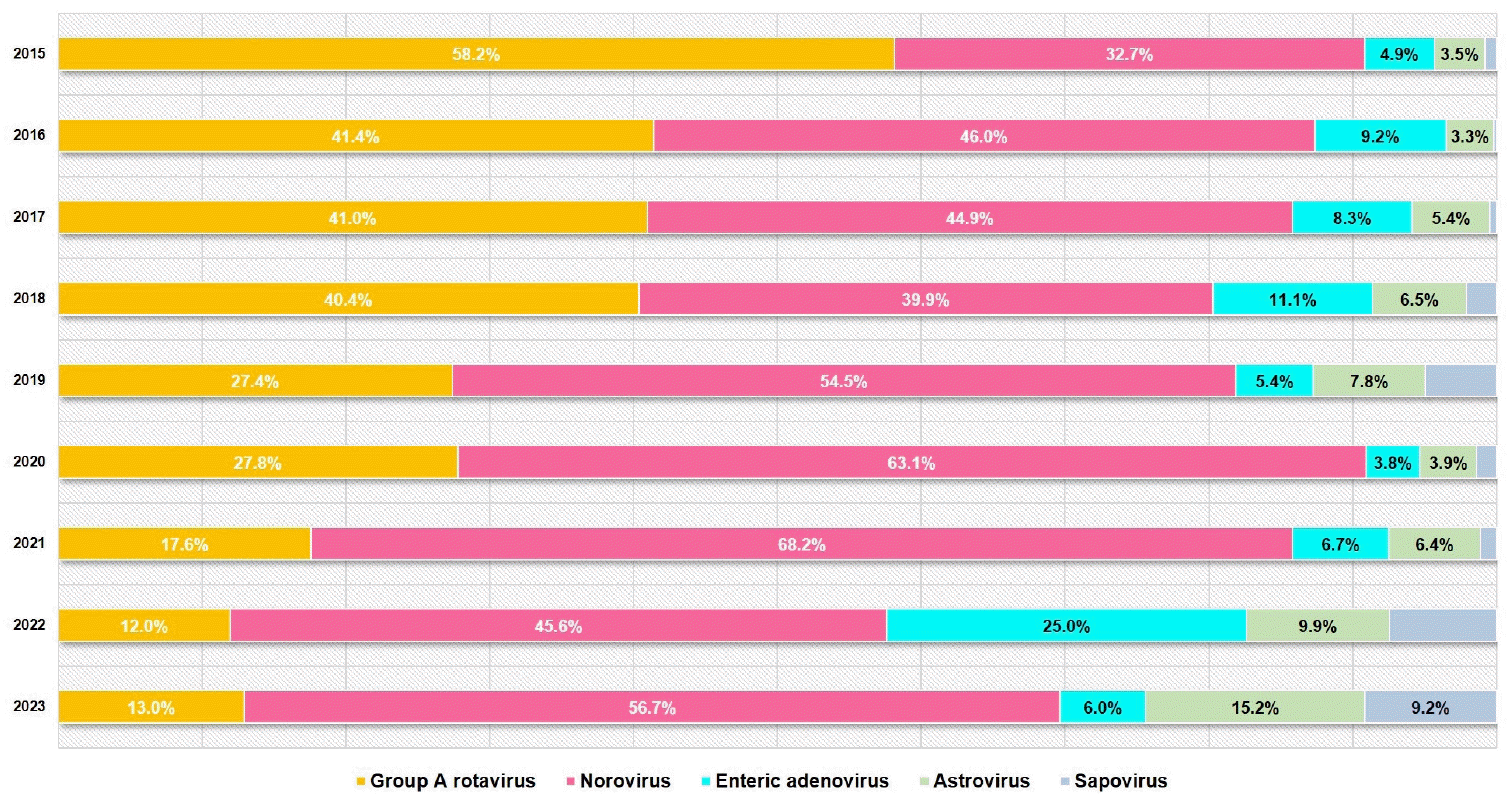Impact of COVID-19 pandemic on clinical features of benign convulsions with mild gastroenteritis
Article information
Key message
· The frequency of benign convulsions with mild gastroenteritis (CwG) was not significantly influenced by the pandemic.
· The coronavirus disease 2019 pandemic has further diversified the etiologic enteric viral pathogens of CwG.
Over the course of approximately 3 years, the coronavirus disease 2019 (COVID-19) pandemic caused by sudden acute respiratory syndrome coronavirus 2 has instilled the fear of a fatal respiratory infection as well as heightened awareness of other infectious diseases. During this period, we adhered to physical distancing rules and paid increased attention to the correct use of personal protective equipment, proper hand hygiene, and appropriate environmental cleaning and disinfection. These lifestyle changes significantly affect the frequency and patterns of gastrointestinal diseases in young children, in whom fecal-to-oral transmission is the predominant infective mode. A Spanish study reported an almost 50% reduction in the prevalence of enteric viruses in children under 5 years of age compared to the prepandemic period [1]. Similarly, a study in Turkey observed a decreased rate of rotavirus positivity in children from 11.3% to 7.5% as well as from 3.1% to 2% for adenovirus during the pandemic [2]. In U.S. surveillance data, including the COVID-19 pandemic period, statistically significantly less rotavirus activity has been reported [3]. An analysis of open data from the Korea Disease Control and Prevention Agency (KDCA) revealed that the overall virus detection rate decreased to 31.9% compared to the pandemic period [4]. In particular, norovirus decreased the most at 40.2%, followed by rotavirus at 31.8% and enteric adenovirus at 13.4%.
Benign convulsions with mild gastroenteritis (CwG) are among the most common neurological complications caused by enteric viruses. CwG is characterized by seizure clustering, a duration <5 minutes, and mostly generalized seizures in previously healthy children occurring in conjunction with acute viral gastroenteritis. Despite the manifestation of frightening seizures, CwG usually stop within 24 hours of their onset and have a good prognosis [5]. A study analyzing nationwide data in South Korea reported the prevalence of CwG attributed to the most common pathogens, rotavirus and norovirus, as 0.013%–0.024% and 0.00001%, respectively [6]. While studies of enteric viral pathogens and their direct or indirect mechanisms involving the central nervous system have been reported, the underlying pathophysiology of CwG remains to be elucidated [7].
Na et al. [8] analyzed the impact of changes in enteric viral infections on the clinical aspects of CwG before and after the COVID-19 pandemic. They analyzed data of CwG cases occurring at a single tertiary center from the past 6 years before and after the pandemic and identified 3 significant findings. First, the frequency of CwG was not significantly influenced by the pandemic (2.9% vs. 4.4%). The authors suggested that this might be attributed to young children, particularly those aged ≤3 years, who were less affected by personal hygiene practices during the pandemic.Interestingly, stool sample collection for national gastroenteritis surveillance by the KDCA showed a sharp decline only in the early stages of the pandemic, with no significant difference compared with 3 years before and after the pandemic [9]. Second, the seasonal variation in CwG incidence based on the causative pathogen disappeared during the COVID-19 pandemic. This could be attributed to norovirus, which varies less depending on the season and is the most common pathogen during the pandemic period [5]. Third, enteric adenovirus-associated CwG, which previously received less attention, has increased. Compared with norovirus-associated CwG, it showed slightly higher serum uric acid and lactate levels, but the overall clinical characteristics did not differ significantly.
Since 2015, the KDCA has been continuously surveilling 5 gastrointestinal infection-related viruses (Fig. 1). Following the introduction of rotavirus vaccines, the proportion of group A rotaviruses has consistently decreased, whereas that of norovirus has increased annually, becoming the most common viral pathogen. Beyond the COVID-19 pandemic period, a noticeable decrease in norovirus-associated gastroenteritis was observed along with a relative increase in minor viral pathogens, such as enteric adenovirus, astrovirus, and sapovirus.

Annual changes in the proportion of gastrointestinal infection-related viruses in South Korea confirmed in an analysis of open data from the Korea Disease Control and Prevention Agency.
It is worth noting that the reduction in the prevalence of rotavirus gastroenteritis does not affect the prevalence of rotavirus-associated CwG, although the number of cases has decreased [6]. Instead, there is a trend toward a relative increase in the prevalence of norovirus-associated CwG [10]. Although the COVID-19 pandemic further diversified the etiologic enteric viral pathogens of CwG, the clinical differences in CwG based on the causative virus have not yet been clearly delineated, necessitating further research.
Notes
Conflicts of interest
No potential conflict of interest relevant to this article was reported.
Funding
This study received no specific grant from any funding agency in the public, commercial, or not-for-profit sectors.
